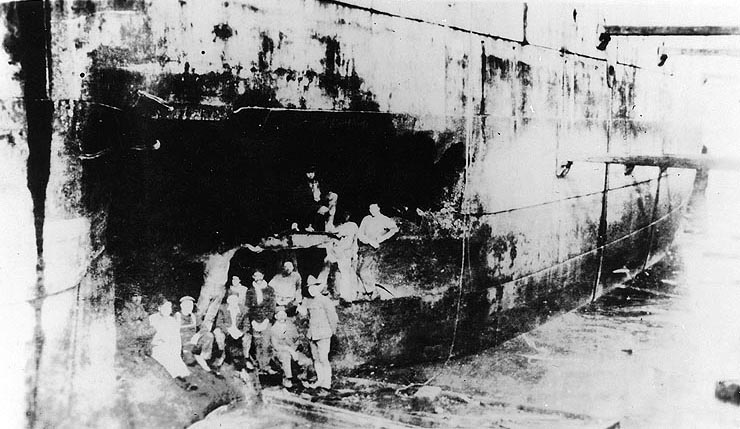|
SM UC-60
SM ''UC-60'' was a German Type UC II minelaying submarine or U-boat in the German Imperial Navy (german: Kaiserliche Marine) during World War I. The U-boat was ordered on 12 January 1916, laid down on 31 March 1916, and was launched on 8 November 1916. She was commissioned into the German Imperial Navy on 25 June 1917 as SM ''UC-60''."SM" stands for "Seiner Majestät" ( en, His Majesty's) and combined with the ''U'' for ''Unterseeboot'' would be translated as ''His Majesty's Submarine''. In one patrols ''UC-60'' was credited with sinking one ship, either by torpedo or by mines laid. ''UC-60'' was surrendered on 23 February 1919 and was broken up at Rainham in 1921. Design A German Type UC II submarine, ''UC-60'' had a displacement of when at the surface and while submerged. She had a length overall of , a beam of , and a draught of . The submarine was powered by two six-cylinder four-stroke diesel engines each producing (a total of ), two electric motors producing , and t ... [...More Info...] [...Related Items...] OR: [Wikipedia] [Google] [Baidu] |
German Empire
The German Empire (),Herbert Tuttle wrote in September 1881 that the term "Reich" does not literally connote an empire as has been commonly assumed by English-speaking people. The term literally denotes an empire – particularly a hereditary empire led by an emperor, although has been used in German to denote the Roman Empire because it had a weak hereditary tradition. In the case of the German Empire, the official name was , which is properly translated as "German Empire" because the official position of head of state in the constitution of the German Empire was officially a "presidency" of a confederation of German states led by the King of Prussia who would assume "the title of German Emperor" as referring to the German people, but was not emperor of Germany as in an emperor of a state. –The German Empire" ''Harper's New Monthly Magazine''. vol. 63, issue 376, pp. 591–603; here p. 593. also referred to as Imperial Germany, the Second Reich, as well as simply Germany, ... [...More Info...] [...Related Items...] OR: [Wikipedia] [Google] [Baidu] |
World War I
World War I (28 July 1914 11 November 1918), often abbreviated as WWI, was one of the deadliest global conflicts in history. Belligerents included much of Europe, the Russian Empire, the United States, and the Ottoman Empire, with fighting occurring throughout Europe, the Middle East, Africa, the Pacific, and parts of Asia. An estimated 9 million soldiers were killed in combat, plus another 23 million wounded, while 5 million civilians died as a result of military action, hunger, and disease. Millions more died in genocides within the Ottoman Empire and in the 1918 influenza pandemic, which was exacerbated by the movement of combatants during the war. Prior to 1914, the European great powers were divided between the Triple Entente (comprising France, Russia, and Britain) and the Triple Alliance (containing Germany, Austria-Hungary, and Italy). Tensions in the Balkans came to a head on 28 June 1914, following the assassination of Archduke Franz Ferdin ... [...More Info...] [...Related Items...] OR: [Wikipedia] [Google] [Baidu] |
List Of Shipwrecks In October 1917
The list of shipwrecks in October 1917 includes ship A ship is a large watercraft that travels the world's oceans and other sufficiently deep waterways, carrying cargo or passengers, or in support of specialized missions, such as defense, research, and fishing. Ships are generally distinguished ...s sunk, foundered, grounded, or otherwise lost during October 1917. 1 October 2 October 3 October 4 October 5 October 6 October 7 October 8 October 9 October 10 October 11 October 12 October 13 October 14 October 15 October 16 October 17 October 18 October 19 October 20 October 21 October 22 October 23 October 24 October 25 October 26 October 27 October ... [...More Info...] [...Related Items...] OR: [Wikipedia] [Google] [Baidu] |
Displacement (ship)
The displacement or displacement tonnage of a ship is its weight. As the term indicates, it is measured indirectly, using Archimedes' principle, by first calculating the volume of water displaced by the ship, then converting that value into weight. Traditionally, various measurement rules have been in use, giving various measures in long tons. Today, tonnes are more commonly used. Ship displacement varies by a vessel's degree of load, from its empty weight as designed (known as "lightweight tonnage") to its maximum load. Numerous specific terms are used to describe varying levels of load and trim, detailed below. Ship displacement should not be confused with measurements of volume or capacity typically used for commercial vessels and measured by tonnage: net tonnage and gross tonnage. Calculation The process of determining a vessel's displacement begins with measuring its draft.George, 2005. p.5. This is accomplished by means of its "draft marks" (or "load lines"). A mer ... [...More Info...] [...Related Items...] OR: [Wikipedia] [Google] [Baidu] |
Propeller Shaft
A drive shaft, driveshaft, driving shaft, tailshaft (Australian English), propeller shaft (prop shaft), or Cardan shaft (after Girolamo Cardano) is a component for transmitting mechanical power and torque and rotation, usually used to connect other components of a drivetrain that cannot be connected directly because of distance or the need to allow for relative movement between them. As torque carriers, drive shafts are subject to torsion and shear stress, equivalent to the difference between the input torque and the load. They must therefore be strong enough to bear the stress, while avoiding too much additional weight as that would in turn increase their inertia. To allow for variations in the alignment and distance between the driving and driven components, drive shafts frequently incorporate one or more universal joints, jaw couplings, or rag joints, and sometimes a splined joint or prismatic joint. History The term ''driveshaft'' first appeared during the mid-19th centu ... [...More Info...] [...Related Items...] OR: [Wikipedia] [Google] [Baidu] |
Draught (ship)
The draft or draught of a ship's hull is the vertical distance between the waterline and the bottom of the hull (keel). The draught of the vessel is the maximum depth of any part of the vessel, including appendages such as rudders, propellers and drop keels if deployed. Draft determines the minimum depth of water a ship or boat can safely navigate. The related term air draft is the maximum height of any part of the vessel above the water. The more heavily a vessel is loaded, the deeper it sinks into the water, and the greater its draft. After construction, the shipyard creates a table showing how much water the vessel displaces based on its draft and the density of the water (salt or fresh). The draft can also be used to determine the weight of cargo on board by calculating the total displacement of water, accounting for the content of the ship's bunkers, and using Archimedes' principle. The closely related term "trim" is defined as the difference between the forward and aft ... [...More Info...] [...Related Items...] OR: [Wikipedia] [Google] [Baidu] |
Beam (ship)
The beam of a ship is its width at its widest point. The maximum beam (BMAX) is the distance between planes passing through the outer extremities of the ship, beam of the hull (BH) only includes permanently fixed parts of the hull, and beam at waterline (BWL) is the maximum width where the hull intersects the surface of the water. Generally speaking, the wider the beam of a ship (or boat), the more initial stability it has, at the expense of secondary stability in the event of a capsize, where more energy is required to right the vessel from its inverted position. A ship that heels on her ''beam ends'' has her deck beams nearly vertical. Typical values Typical length-to-beam ratios ( aspect ratios) for small sailboats are from 2:1 (dinghies to trailerable sailboats around ) to 5:1 (racing sailboats over ). Large ships have widely varying beam ratios, some as large as 20:1. Rowing shells designed for flatwater racing may have length to beam ratios as high as 30:1, while a cor ... [...More Info...] [...Related Items...] OR: [Wikipedia] [Google] [Baidu] |
Length Overall
__NOTOC__ Length overall (LOA, o/a, o.a. or oa) is the maximum length of a vessel's hull measured parallel to the waterline. This length is important while docking the ship. It is the most commonly used way of expressing the size of a ship, and is also used for calculating the cost of a marina berth (for example, £2.50 per metre LOA). LOA is usually measured on the hull alone. For sailing ships, this may ''exclude'' the bowsprit and other fittings added to the hull. This is how some racing boats and tall ships use the term LOA. However, other sources may include bowsprits in LOA. Confusingly, LOA has different meanings. "Sparred length", "Total length including bowsprit", "Mooring length" and "LOA including bowsprit" are other expressions that might indicate the full length of a sailing ship. LOD Often used to distinguish between the length of a vessel including projections (e.g. bow sprits, etc.) from the length of the hull itself, the Length on Deck or LOD is often repor ... [...More Info...] [...Related Items...] OR: [Wikipedia] [Google] [Baidu] |
Rainham, Kent
Rainham ( ) is a town in the unitary authority of Medway, in Kent, South East England. The town forms a conurbation with neighbouring towns Chatham, Rochester, Strood and Gillingham. Historically, Rainham was a separate village until, in 1928, it was added to the Municipal Borough of Gillingham, which was originally created in 1903 and was grouped into the latter's built-up area in analysis of the 2011 census by the Office for National Statistics. It became part of the Medway authority when Gillingham was incorporated with the other towns to form Medway Unitary Authority in 1998. Geography Rainham occupies a large stretch of land from the dip slope of a moderate rise of the North Downs of about above sea level, descending to a frontage on the River Medway's natural harbour to the north. London is approximately to the west. Three roads cross the town. The M2 motorway runs along its southern edge, from the town centre. The main road through the town, the A2, follows the an ... [...More Info...] [...Related Items...] OR: [Wikipedia] [Google] [Baidu] |
Naval Mines
A naval mine is a self-contained explosive device placed in water to damage or destroy surface ships or submarines. Unlike depth charges, mines are deposited and left to wait until they are triggered by the approach of, or contact with, any vessel or a particular vessel type, akin to anti-infantry vs. anti-vehicle mines. Naval mines can be used offensively, to hamper enemy shipping movements or lock vessels into a harbour; or defensively, to protect friendly vessels and create "safe" zones. Mines allow the minelaying force commander to concentrate warships or defensive assets in mine-free areas giving the adversary three choices: undertake an expensive and time-consuming minesweeping effort, accept the casualties of challenging the minefield, or use the unmined waters where the greatest concentration of enemy firepower will be encountered. Although international law requires signatory nations to declare mined areas, precise locations remain secret; and non-complying individual ... [...More Info...] [...Related Items...] OR: [Wikipedia] [Google] [Baidu] |

.jpg)



